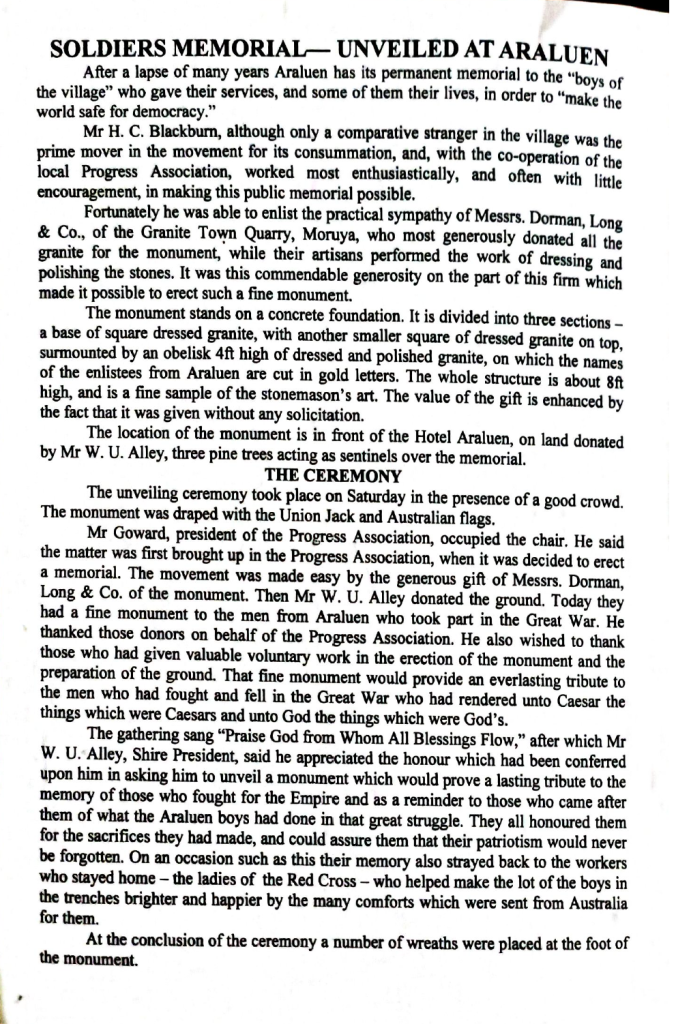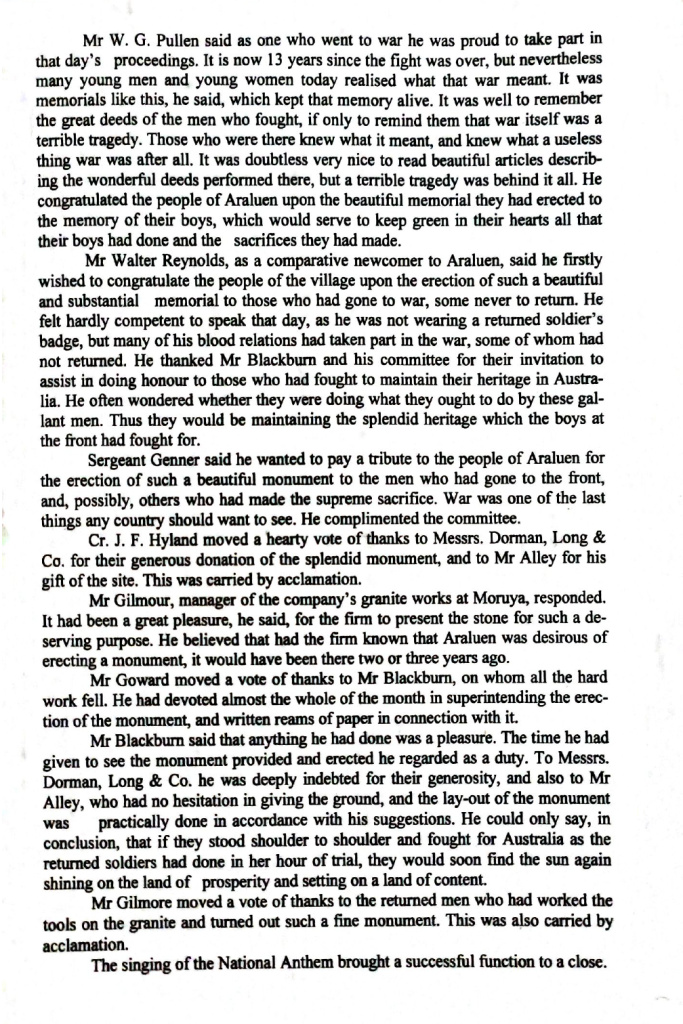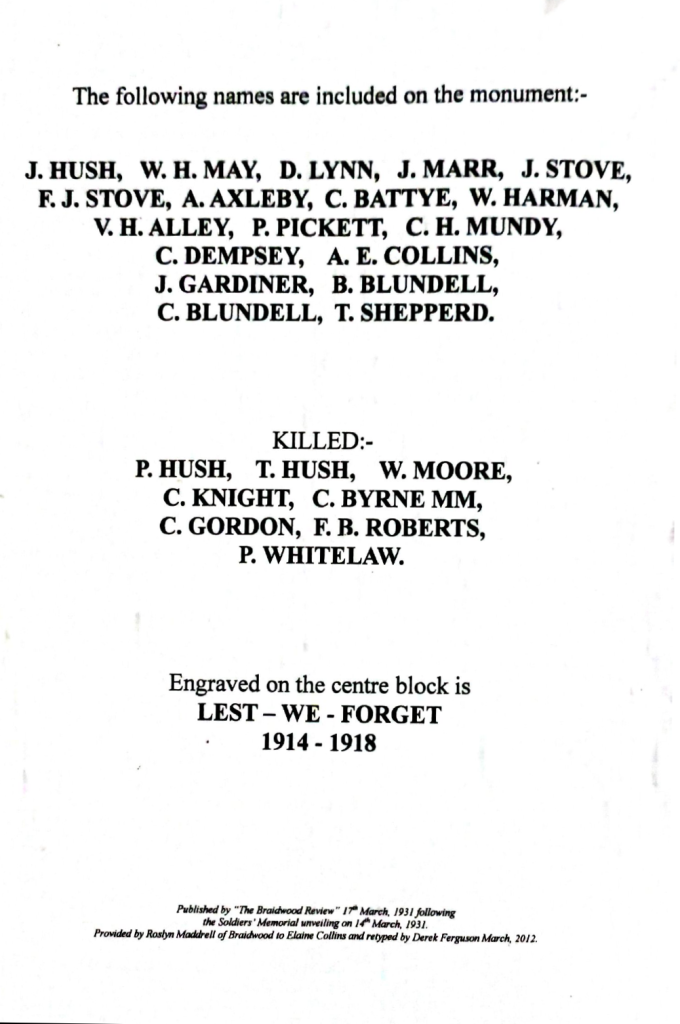The following is a reprint of an article published by ‘The Braidwood Review’ on I7 March 1931 following the Soldiers’ Memorial unveiling on 14 March 1931.1Braidwood Review and District Advocate (NSW : 1914-1954), Tuesday 17 March 1931, p 3. The article was also reprinted and published as a brochure in 2012.

Soldiers memorial unveiled at Araluen
After a lapse of many years Araluen has its permanent memorial to the ‘boys of the village’ who gave their services, and some of them their lives, in order to ‘make the world safe for democracy’.
Mr H. C. Blackburn, although only a comparative stranger in the village was the prime mover in the movement for its consummation, and, with the co-operation of the local Progress Association, worked most enthusiastically, and often with little encouragement, in making this public memorial possible.
Fortunately he was able to enlist the practical sympathy of Messrs. Dorman, Long & Co., of the Granite Town Quarry, Moruya, who most generously donated all the granite for the monument, while their artisans performed the work of dressing and polishing the stones. It was this commendable generosity on the part of this firm which made it possible to erect such a fine monument.
The monument stands on a concrete foundation. It is divided into three sections – a base of square dressed granite, with another smaller square of dressed granite on top, surmounted by an obelisk 4ft high of dressed and polished granite, on which the names of the enlistees from Araluen are cut in gold letters. The whole structure is about 8ft high, and is a fine sample of the stonemason’s art. The value of the gift is enhanced by the fact that it was given without any solicitation.
The location of the monument is in front of the Hotel Araluen, on land donated by Mr W. U. Alley, three pine trees acting as sentinels over the memorial.
The Ceremony

The unveiling ceremony took place on Saturday in the presence of a good crowd. The monument was draped with the Union Jack and Australian flags.
Mr Goward, president of the Progress Association, occupied the chair. He said the matter was first brought up in the Progress Association, when it was decided to erect a memorial. The movement was made easy by the generous gift of Messrs. Dorman, Long & Co. of the monument. Then Mr W. U. Alley donated the ground. Today they had a fine monument to the men from Araluen who took part in the Great War. He thanked those donors on behalf of the Progress Association. He also wished to thank those who had given valuable voluntary work in the erection of the monument and the preparation of the ground. That fine monument would provide an everlasting tribute to the men who had fought and fell in the Great War who had rendered unto Caesar the things which were Caesars and unto God the things which were God’s.
The gathering sang ‘Praise God from Whom All Blessings Flow’, after which Mr W. U. Alley, Shire President, said he appreciated the honour which had been conferred upon him in asking him to unveil a monument which would prove a lasting tribute to the memory of those who fought for the Empire and as a reminder to those who came after them of what the Araluen boys had done in that great struggle. They all honoured them for the sacrifices they had made, and could assure them that their patriotism would never be forgotten. On an occasion such as this, their memory also strayed back to the workers who stayed home – the ladies of the Red Cross – who helped make the lot of the boys in the trenches brighter and happier by the many comforts which were sent from Australia for them.
At the conclusion of the ceremony a number of wreaths were placed at the foot of the monument.

Mr W. G. Pullen said as one who went to war he was proud to take part in that day’s proceedings. It is now 13 years since the fight was over, but nevertheless many young men and young women today realised what that war meant. It was memorials like this, he said, which kept that memory alive. It was well to remember the great deeds of the men who fought, if only to remind them that war itself was a terrible tragedy. Those who were there knew what it meant, and knew what a useless thing war was after all. It was doubtless very nice to read beautiful articles describing the wonderful deeds performed there, but a terrible tragedy was behind it all. He congratulated the people of Araluen upon the beautiful memorial they had erected to the memory of their boys, which would serve to keep green in their hearts all that their boys had done and the sacrifices they had made.
Mr Walter Reynolds, as a comparative newcomer to Araluen, said he firstly wished to congratulate the people of the village upon the erection of such a beautiful and substantial memorial to those who had gone to war, some never to return. He felt hardly competent to speak that day, as he was not wearing a returned soldier’s badge, but many of his blood relations had taken part in the war, some of whom had not returned. He thanked Mr Blackburn and his committee for their invitation to assist in doing honour to those who had fought to maintain their heritage in Australia. He often wondered whether they were doing what they ought to do by these gallant men. Thus they would be maintaining the splendid heritage which the boys at the front had fought for.
Sergeant Genner said he wanted to pay a tribute to the people of Araluen for the erection of such a beautiful monument to the men who had gone to the front, and, possibly, others who had made the supreme sacrifice. War was one of the last things any country should want to see. He complimented the committee.
Cr. J. F. Hyland moved a hearty vote of thanks to Messrs. Dorman, Long & Co. for their generous donation of the splendid monument, and to Mr Alley for his gift of the site. This was carried by acclamation.
Mr Gilmour [Gilmore], manager of the company’s granite works at Moruya, responded. It had been a great pleasure, he said, for the firm to present the stone for such a deserving purpose. He believed that had the firm known that Araluen was desirous of erecting a monument, it would have been there two or three years ago.
Mr Goward moved a vote of thanks to Mr Blackburn, on whom all the hard work fell. He had devoted almost the whole of the month in superintending the erection of the monument, and written reams of paper in connection with it.
Mr Blackburn said that anything he had done was a pleasure. The time he had given to see the monument provided and erected he regarded as a duty. To Messrs. Dornan, Long & Co. he was deeply indebted for their generosity, and also to Mr Alley, who had no hesitation in giving the ground, and the lay-out of the monument was practically done in accordance with his suggestions. He could only say, in conclusion, that if they stood shoulder to shoulder and fought for Australia as the returned soldiers had done in her hour of trial, they would soon find the sun again shining on the land of prosperity and setting on a land of content.
Mr Gilmore moved a vote of thanks to the returned men who had worked the tools on the granite and turned out such a fine monument. This was also carried by acclamation.
The singing of the National Anthem brought a successful function to a close.
The following names are included on the monument:

J. HUSH, W. H. MAY, D. LYNN, J. MARR,
J. STOVE, FJ. STOVE, A. AXLEBY, C. BATTYE, W. HARMAN,
V. H. ALLEY, P. PICKETT, C. H. MUNDY,
C. DEMPSEY, A. E. COLLINS,
J. GARDINER, B. BLUNDELL,
C. BLUNDELL, T. SHEPPERD.
KILLED:-
P. HUSH, T. HUSH, W. M0ORE,
C. KNIGHT, C.BYRNE MM,
C. GORDON, F B. ROBERTS, P. WHITELAW.
Engraved on the centre block is:
LEST- WE- FORGET
1914 – 1918
Published by ‘The Braidwood Review’ on I7 March, 1931 following the Soldiers’ Memorial unveiling on 14 March 1931.
Provided by Roslyn Maddrell of Braidwood to Elaine Collins and retyped by Derek Ferguson March, 2012.